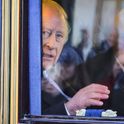Just a month ago, businessman Donald Trump stood on the steps of Washington DC's majestic Capitol Building and, hand on Bible, swore to preserve, defend and protect the Constitution of the United States. Large crowds (though not as large as he later claimed) had gathered on the National Mall to celebrate the inauguration of perhaps the most controversial President-Elect in modern American history. They cheered, applauded and chanted his name.
In the surrounding streets, others protested. Members of the anti-war Answer Coalition, Black Lives Matter, the Socialist Workers' Party, LGBT organisations, climate change activists—dozens of organisations representing different concerns, and thousands of individuals, marched peacefully near the Mall or attempted to disrupt the inauguration ceremony. A small handful of those protesting became violent. A group with their faces covered stormed towards the parade route, smashing windows and setting a car on fire before being stopped by police with pepper spray.
That was day one. The following day, an estimated half a million people marched along the same roads to demand the protection of women's rights under the Trump administration, including reproductive rights and protection from sexual violence.
In the weeks since then, the protests have barely let up. On Monday, thousands gathered in cities across the US to mark President's Day, an annual public holiday, with chants of “Not My President.” As part of this, a march took place in the streets outside the White House.
But although momentum and dissent is still strong, many are beginning to question where it is going and what it can achieve.
I arrived in Washington, DC, on Sunday, 22nd January—two days after the inauguration—to a city laden with a confused mingling of messages. In the streets surrounding the Mall, banners congratulating the new president hung from the buildings. Stalls selling Trump t-shirts and inauguration day sweaters still lined the pavements. But sodden, trampled cardboard signs bearing slogans such as “This Pussy Grabs Back” (a reference to Trump's boast about grabbing women “by the pussy”) and “The Future is Female” were left lying along the roadside. Others had been carefully propped up on walls and park benches, preserving their messages for longer. A Starbucks near the parade route had a smashed window from where rioters had attacked it as they streamed past its doors.
Although DC itself is a deeply liberal city—91 per cent of residents voted for Hillary Clinton—the US capital had been flooded with citizens bringing different messages and many had remained over the weekend. Pedestrians wearing brightly-coloured “Make America Great Again” caps passed by others in pink “pussy hats”—knitted beanies with cats ears that have been worn as a symbol of protest against Trump's attitude to women—largely ignoring each other's presence.
Evenings and weekends have seen endless disruptions—from protests to vigils—repeatedly shutting down the busy streets around Pennsylvania Avenue, the wide, symbolic road that leads from the White House to the Capitol. “They might as well set up a permanent street diversion for the rest of this administration,” one driver complained.
The causes have been varied. On Friday 27th, a week after the inauguration, huge crowds descended on the city for the annual March for Life, an anti-abortion rally addressed by Vice President Mike Pence. An enormous river of people flowed through the streets chanting: “Hey, hey, ho, ho, Roe v Wade has got to go!” I watched a small cluster of counter-protesters wearing pussy hats bravely march along on the pavement beside them, clutching signs bearing pro-choice messages, until they encountered a man in a stars and stripes scarf selling Trump baseball caps on a corner. “If Trump's not your President, you're not American!” he yelled at them—several times—as they passed by. “You're outnumbered here!” someone else joined in.
Since then, disruptions have generally challenged the actions and orders of the new president. The day after that march, Trump signed his executive order banning citizens from seven Muslim-majority countries from entering the US. Some hundreds or thousands of residents and lawyers spontaneously gathered at the city's international airport to rally on behalf of those who had been detained.
Subsequent protests have centered on cabinet appointments, the Supreme Court nomination of Neil Gorsuch, minority rights and immigration raids. Day after day, Washingtonians have left work and headed towards the Mall to voice their opposition to the actions of their new president, or given up their weekends to march in the freezing cold for the cause. Many more have driven in from out of town. It is, by now, well-rehearsed—signs at the ready, loud speakers acquired, chants familiar to all. A call goes out on Facebook, news is spread by word of mouth and hundreds or thousands assemble.
One resident who has lived in the city for 30 years told me that, although DC is often a focal point for dissent, he had never before witnessed such a density or intensity of protests.
Yet for those opposed to the administration's agenda, it is hard to know whether protests can be turned into results. Trump appears uninterested in paying even lip service to the protesters' concerns or in attempting to unite his public. For the moment, momentum is strong, renewed in response to each new order issued by the president. But some worry that if protest feels futile, fatigue will soon set in.
One strategy tried by protesters in DC is to “hit him where it hurts.” The Sunday after he announced his controversial travel ban, instead of targeting federal buildings, thousands of people surrounded the city's Trump International Hotel. For more than four hours, they blocked off the street outside, chanting “Shame on you!” and “Take back the lease!” Rattled employees locked the grand oak doors—usually attended by sharply-dressed doormen—and retreated inside. Guests, if there were any, also tucked themselves away: I saw nobody at the entrances or windows throughout the entire event. Since then, barriers have prevented protesters from reaching the doors, but the hotel was targeted a second time soon afterwards when activists held an LGBT dance party outside.
Some I spoke to were hopeful this tactic would force Trump to pay attention to the protests; others, more resigned, said that his business interests are so extensive it would be hard to have any real impact on them. The online campaign #GrabYourWallet, which urges citizens to boycott Trump family businesses, appears to be having some success. Several companies have announced they will stop selling products carrying the Trump name, apparently due to dwindling sales. But business impact will not necessarily translate into policy impact.
Others I spoke to pointed to the role of lawyers at the airport protests, who volunteered to provide legal support for those detained, as reason to hope that demonstrations may have some influence on the direction of policy.
But some may also feel that with Trump and his supporters criticising those who demonstrate, dismissing them as “paid” and even threatening to withdraw federal funding from cities and institutions that do not fall in line, it is important simply to assert the democratic right to protest by refusing to back down. With dozens of demonstrations planned for the capital in the coming weeks and months—from the March for Science to the Immigrants' March—and others likely to spring up spontaneously, the streets of DC will be shut down again, filled with a growing cacophony of messages.
Will Trump protests work?
In DC, demonstrations have been constant—but are they resistance for resistance’s sake?
February 24, 2017

January 29th, 2017: Thousands protest Trump's travel ban ©Miguel Juarez Lugo Zuma Press/PA Images











